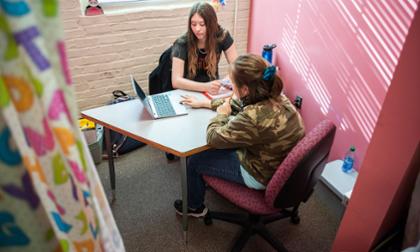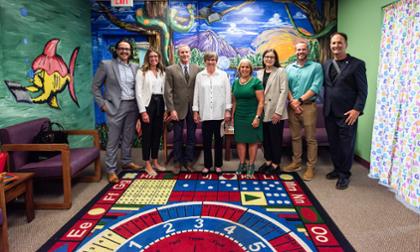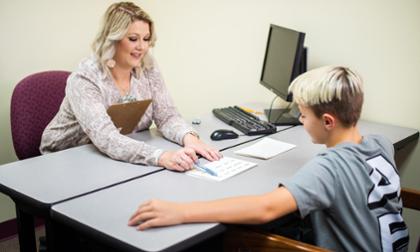It’s called the Center for Reading, and for now it’s located in an unassuming office on the second floor of Whitesitt Hall — an historic building at Pittsburg State University used for a mix of programs and services.
“I’d guess that most people in Pittsburg, and certainly many right here on campus, don’t know we are here and what we do,” said Executive Director Dr. David Hurford, a professor of Psychology who for many years also served chair of the Psychology & Counseling Department.

Hurford founded the Center in 1996 to serve individuals with dyslexia and other reading difficulties using a system he developed. It provides evaluation, science-based intervention, and advocacy services, all based on best practices.
University President Dan Shipp, who has dyslexia, is working with Hurford to elevate the visibility and accessibility of the center, reassigning it to a newly branded Economic Development and Community Engagement division under the leadership of Vice President Shawn Naccarato.
By 2026, it’s tabbed to be part of the Gorilla Rising project in downtown Pittsburg near Block22.
“This has the capacity to put our community, our region, on a new and exciting trajectory,” Naccarato said. “What David is doing is life-changing — it has significant impact.”
Individuals with dyslexia and other reading difficulties are more likely to drop out of high school and experience a negative self-image. Specific learning disabilities such as dyslexia are often associated with lower academic achievement, lower income, higher rates of suicidality, and higher rates of unemployment.
Nearly 40 percent of students across the country read below the basic reading level.
"Reading failure is a systemic problem that is correctable and we are here to help with the changes that will be necessary for all children to learn to read,” Hurford said.
Families with children who are struggling to read bring them to Pittsburg from states — and sometimes countries — away, hoping for help. What they find is a scientific approach that teaches children to “decode” what they’re reading.
Hurford, considered a noted expert, has written and published a curriculum now used by classroom teachers across the country, is often interviewed by national publications, and was invited to serve on a statewide dyslexia task force.
Last summer, New Mexico Gov. Michelle Lujan Grisham and a delegation that included Children’s Cabinet Director Mariana Padilla and Higher Education Secretary Stephanie Rodriguez visited the Center to meet Hurford’s team and learn more.
They were joined by Kansas Gov. Laura Kelly.
Their goal: to learn what changes need to be made to ensure the state’s teachers, school administrators, institutions of higher education, and parents are all on the same page when it comes to literacy instruction. And more importantly, ways to make those changes.
About a third of New Mexico students read at grade level, and nearly 30 percent of New Mexico adults reads at or below Level 1.
“We were impressed by the research and teaching methods employed at the Center for Reading,” Lujan Grisham said. “Our goal is to bring back valuable insights and best practices that can help improve literacy for all students in New Mexico.”

By September, she had announced plans to request $30 million from the Legislature to construct an institute focused on improving literacy skills and invited Hurford to be a guest at a summit attended by stakeholders.
Part of her strategy: making sure New Mexico colleges and universities are adequately trained in the science of reading to students in its education program.
“Hats off to the Governor for understanding that what we need in New Mexico is a systematic change in how we train teachers to teach reading,” Pro Tem Mimi Stewart said. “All students can learn to read if we train our educators to use these evidence-based strategies."
Public Education Cabinet Secretary Arsenio Romero described it as a bold, decisive direction for the state.
“In my time in classrooms, schools, and districts, I have seen the science of reading deliver results time and again,” he said.
Hurford was humbled to be part of the initiative. Moving forward, he would like to see every state tackle reading challenges like New Mexico is.
“When you see a child who struggles to read and who believes that he or she is simply not intelligent enough to learn to read, become a competent reader, it is mind-blowing,” he said. “His or her confidence soars in other areas once he or she is able to read. We are experiencing a renaissance in reading and it is exciting to be part of it.”

Hurford’s team includes:
Learn more about the Center for Reading, dyslexia, and arrange for services at pittstate.edu/reading